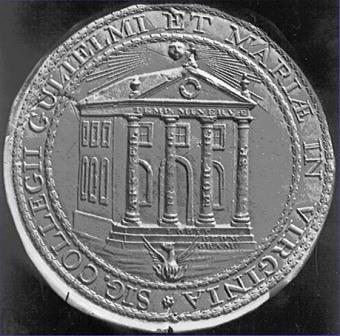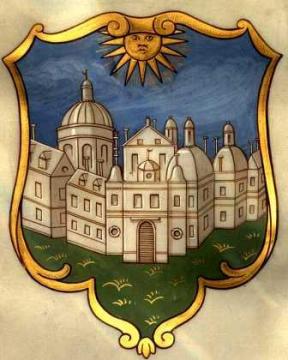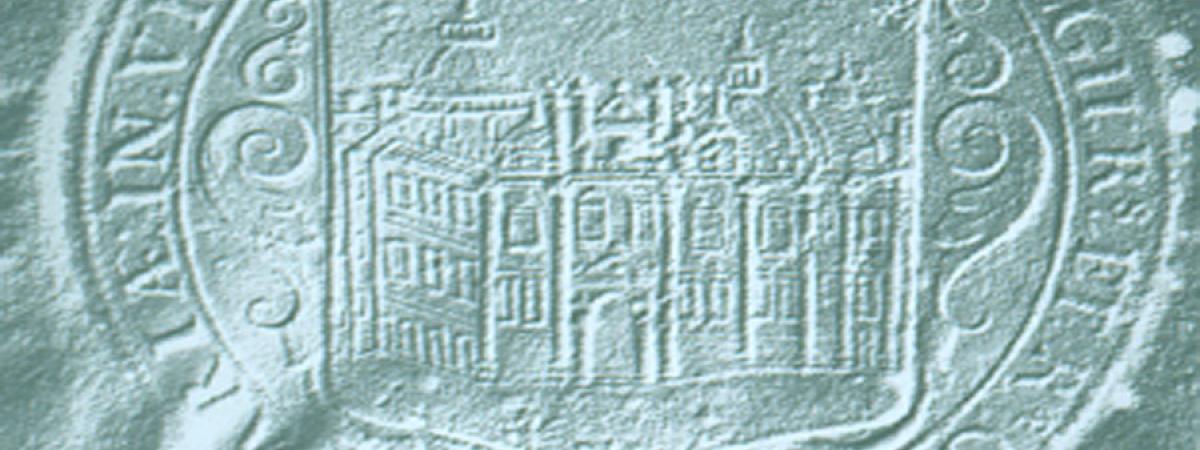William & Mary was the first American institution of higher learning with a royal coat of arms. It was issued on May 14, 1694 by the College of Arms in London. The buildings featured are not modeled on buildings at William & Mary as the coat of arms was received before construction of the Wren Building in Williamsburg was begun. In 1990, the College decided to license their name, Coat of Arms, and other symbols. While there has only been one coat of arms, William & Mary has had three versions of the college seal.
First Seal, 1694-1783

The original seal was used by the College from 1694 through 1783. The earliest document mentioning the seal is a warrant, dated May 2, 1694 from Henry, Duke of Norfolk, Earl Marshal of England to the Kings of Arms. It orders and appoints them to "Devyse, Grant and Assign" arms to the trustees of William & Mary, and requiring them to enter the warrant and grant of arms in the records of the College of Arms.
The arms were described as: "Vert a Colledge, or Edifice Mason'd Argent in Chief a Sun rising Or the Hemisphere proper," i.e., a college building or buildings in silver on a green field with a golden sun at half orb against a blue sky. This is the same seal that appears on a 1749 surveyor's license.
Variation:
- Buildings receding on the left, but not on the right with no dormers on the buildings on the left; outside there is scroll work around the border and a Latin inscription around the whole. Example: Surveyors License of John West, Jr., 1749.
Second Seal, circa 1783-1929

A new seal (variously referred to as the second, temple, Wythe, or Jeffersonian seal) was first presented to Governor Benjamin Harrison in early 1784 and was used through the 1920s. A sample of this seal is an honorary diploma from the College to St. George Tucker dated March 6, 1790. This seal was used without further change or question concerning its authenticity from 1784 until about 1922.
The suggestion of the Thomas Jefferson connection was likely derived from his admiration of classical architecture and the fact that when he was governor of Virginia he was involved in making significant changes at the College. It has been conjectured however that the design of the building "appears far too crude to have been drawn by Jefferson."(Sweig)
The correspondence of James Madison mentions that the seal was conveyed to Williamsburg by George Wythe in 1783. Wythe was in Williamsburg and affiliated with the College at the time the second seal was designed. Wythe had a hand in designing the Virginia state seal, which includes a phoenix as seen on some versions of the second seal. Wythe and Jefferson were friends, so there may have been some exchange between them on the matter, but the strongest case to date has been made for attributing the design of the seal as it was executed by the engraver to Wythe.
The seal depicts a temple, full sun with human face, long rays, phoenix rising from the flame below the steps of the temple. On the frieze the words "Temp. Minervae"; on the steps the words "Logic", "Nat. Ph.", "Mor. Ph.", and "Jurisp." Beginning at the bottom the words "Sig. Collegii Gulielmi et Mariae in Virginia." As executed by engraver Robert Scott of Philadelphia (formerly of Virginia), 1782-1783.
Variations of this design:
- Temple, full sun with human face, long rays, phoenix rising, Latin legend. Examples in the Special Collections Research Center: Alfriend diploma; Red wax impression Acc. 1980.101.
- Temple, full sun with human face, no phoenix, no legend or other words
- Temple, full sun, no face, phoenix rising, words on frieze: "Temp. Minerva" and on steps: "Logic", "Geom.", and "Gram." Used on Board of Visitors award.
- Temple, full sun, solid background, 1693 below temple. Examples: Catalogs 1914/1915 opposite pages 14 & 15; Catalogs January 1919, 1921/1922, 1922/1923; Ring Acc. 1990.25 in University Archives Artifact Collection; College buildings including Tyler, Barrett, Chandler, Jefferson, Monroe, Old Dominion.
- Temple, full sun, no face, Latin inscription around border, no other words. Examples: Catalog 1904-1905.
- Temple, full sun, no face, 1693, inscription in English "College of William & Mary." Example: Buckle Acc. 1989.22 in University Archives Artifact Collection.
Last use of temple seal was in the Catalog Vol. XXIII No. 7, February 1930.
Third Seal, circa 1920s-present

In 1922, a Boston physician began corresponding with Earl Gregg Swem, College librarian, about the seal and suggested that a copy of the official coat of arms might be secured from the College of Arms in London.
A 1749 surveyor's license with a seal featuring the coat of arms was sent to the College in 1926, and in 1929, President J.A.C. Chandler took the opportunity, while already in London, to visit the College of Arms. At Chandler's request, the College of Arms created a facsimile of the Grant of Arms. This item is available in the Special Collections Research Center.
Variations:
- Buildings, full sun with human face, rays, feathery scrolled border with foliage, leaves crossed on field. Drawing from ___ Example in "Coat of Arms," University Archives Subject File Collection.
- Buildings, full sun with human face, rays, scrolled border with foliage, flower on the left as observed, leaves crossed on field. Designed for the Frenchman's Map from Eric M. Simon of ____ of Pittsfield, MA.
- Buildings, full sun with human face, rays, scrolled border, Latin inscription "Sig. Collegii R. et R. Gulielmi et Mariae in Virginia. Used by the Registrar's Office in 1947.
- Buildings, full sun with human face, rays, drapery held with sconces, foliage, no text. Examples: College buildings including Tucker Hall, Blair Hall, Wildflower Refuge (no drapery).
References
- "Surveying--Individuals--West--1749" and "Coat of Arms" (regular and oversize folders), University Archives Subject File Collection, Special Collections Research Center, Swem Library, William & Mary.
- See especially "'Vert a Colledge...': A Study of the Coat-of-Arms and Seals of the College of William & Mary in Virginia," Donald M. Sweig, The Virginia Magazine of History and Biography, vol. 84 no. 2 (April 1976): 142-165 (copy available in "Coat of Arms," University Archives Subject File Collection, Special Collections Research Center, Swem Library, William & Mary).
- "W&M Registers Logo as Official Trademark", Virginia Gazette, 9/20/1990, pg. 6A.
Material in the SCRC
- Surveying--Individuals--West--1749" and "Coat of Arms" (regular and oversize folders), University Archives Subject File Collection, Special Collections Research Center, Swem Library, William & Mary.
- Coat of Arms, University Archives Photograph Collection, Special Collections Research Center, Swem Library, William & Mary.
- University Archives Artifact Collection, various items including: pennants; Alumni Medallion Acc. 1980.068; copy of granting of arms Acc. 1980.100; Acc. 1981.030; Acc. 1981.031; Acc. 1988.011; Acc. 1983.127; Acc. 1991.061; Acc. 1990.012; Acc. 1991.043; Acc. 1989.022; Acc. 1988.077.
- Folder 1: "Arms and Seal of the College of William & Mary, 1698-1930," College Papers Collection, Special Collections Research Center, Swem Library, William & Mary.
- Alexander Kallos Papers, Special Collections Research Center, Swem Library, William & Mary.

